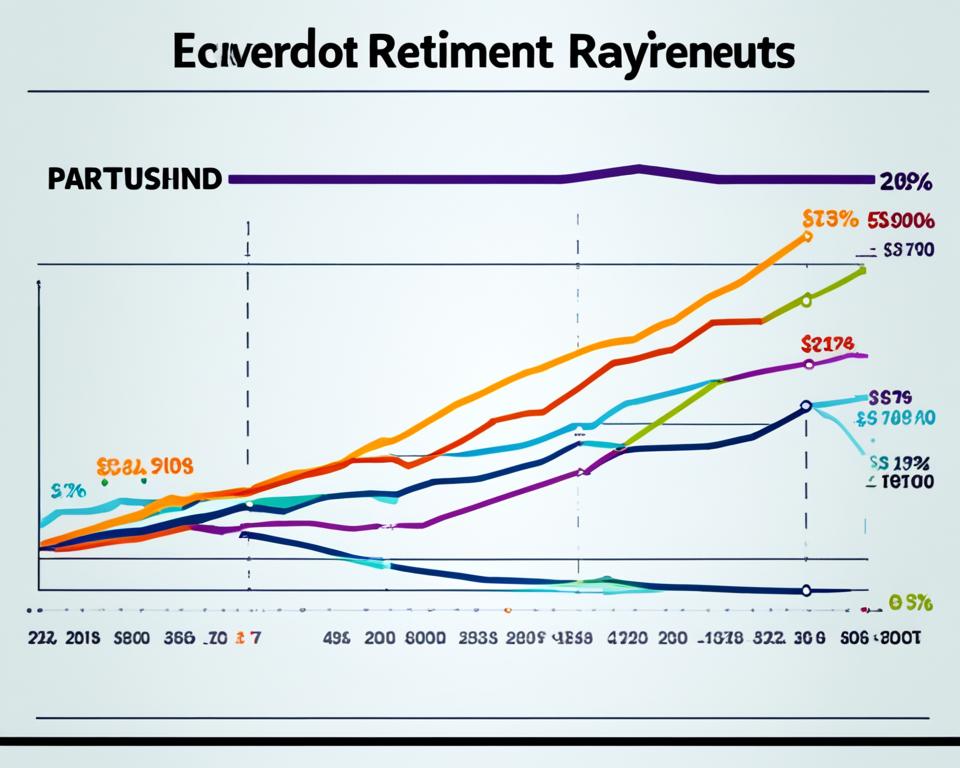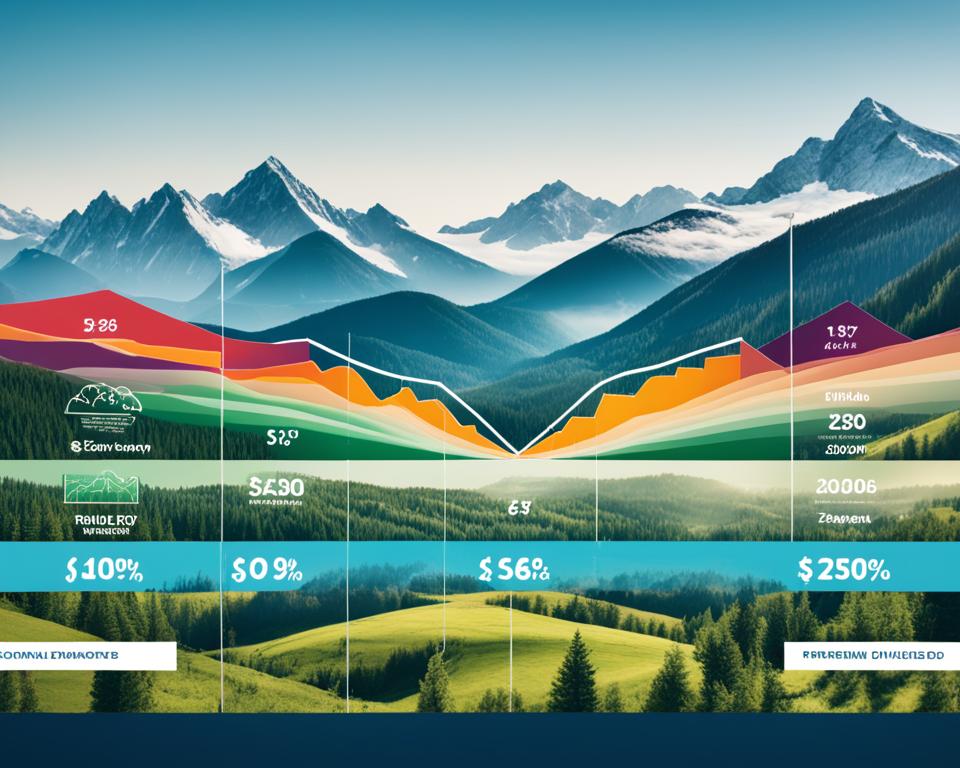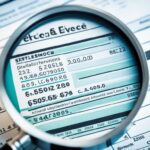Imagine a retirement where you’re unperturbed by the ups and downs of the market, one where your investments generate a steady flow of income. This scenario can become your reality with a well-organized dividend stock retirement strategy. By infusing your portfolio with carefully selected dividend stocks, you create a passive income retirement plan that not only meets your golden-age expenses but potentially exceeds them.
Within this strategy, you’re not compelled to part with your valuable stock shares. Instead, you receive quarterly or monthly dividend payments. For those with an eye towards retirement income investing, the allure of passive income from dividends can’t be overstated. It’s about aligning financial goals with investment decisions that support a relaxed and financially secure retirement.
Key Takeaways
- A dividend stock retirement strategy enables continuous income without selling your investment.
- Quarterly dividends offer a predictable source of funds during retirement.
- Investing in dividend stocks can potentially offer both capital gains and regular income.
- Choosing the right stocks is critical to managing risk and ensuring stable returns.
- Starting early with retirement income investing maximizes the power of compounding dividends.
- A successful passive income retirement plan can alleviate financial stress in your later years.
The Compelling Case for Dividend Stocks in Retirement
When mapping out a retirement strategy, a robust long-term income portfolio often includes a mix of assets, with retirement dividend stocks taking center stage. Their ability to deliver steady cash flow enhances one’s financial resilience against the ebb and flow of market conditions. Recognizing the pivotal role of dividend stocks in retirement planning is key to securing financial peace of mind for your golden years.
Understanding Dividend Stocks and Their Role in Retirement Planning
For dividend investing for retirees, it’s not just about selecting any equity – it’s about choosing those that promise a slice of company profits through dividends. This ongoing income stream can be particularly reassuring when the regular paycheck stops after retirement. Dividends come with the flexibility to be reinvested or used to cover day-to-day expenses, thus maintaining a retiree’s quality of life without tapping into the initial investment principal.
How Consistent Dividend Income Supports a Stress-Free Retirement
Imagine a monthly or quarterly influx that funds your lifestyle without fail – that’s the beauty of dividends. They provide a cushion that absorbs the shock of unforeseen financial needs, offering a sense of stability that is invulnerable to the unpredictability of job markets. A well-curated selection of dividend-yielding stocks serves as the foundation for a passive income retirement plan, fostering a stress-free retirement by addressing the need for a constant cash flow.
Comparing Dividend Stocks with Other Retirement Income Sources
Bonds and savings accounts, though reliable, often yield returns that barely keep pace with inflation, especially in a low-interest environment. In contrast, a long-term income portfolio featuring dividend stocks offers the dual advantage of income plus growth. While direct comparisons might reveal trade-offs between potential returns and risk levels, dividend stocks typically emerge as a more attractive option due to their possible capital appreciation and income-producing ability.
Bond vs. Dividend Stock
| Characteristic | Bond | Dividend Stock |
|---|---|---|
| Income Type | Fixed Interest | Variable Dividends |
| Growth Potential | Limited | Significant |
| Risk Level | Lower (usually) | Varies |
| Inflation Adjustment | Potentially lower real return | Potential for real growth |
Meticulously constructing a retirement strategy that incorporates dividend investing for retirees not only simplifies the financial transition from earning a wage to relying on investment returns but also paves the way for a retirement replete with choices and free from financial constraints.
Essential Criteria for Selecting High-Quality Dividend Stocks
When it comes to retirement planning with dividends, integrating high-quality dividend stocks into your portfolio is crucial. These stocks are the backbone of a dividend growth retirement strategy, designed to sustain your lifestyle throughout retirement. To ensure you’re on the right track, let’s explore the critical criteria for selecting these powerful financial instruments.
Assessing Dividend Yield and Dividend Growth
Evaluating dividend yield is the first step in your stock selection process—it represents the percentage of return you earn from dividends relative to the stock’s price. Yet, high yields can sometimes camouflage underlying risks, so drilling down into the sustainability and growth prospects of dividends is equally vital. Companies that have consistently raised their dividends are often preferred because this signals financial health and a commitment to returning value to shareholders. Look for those with a steady record of dividend growth, as they can potentially enhance your purchasing power against inflation.
Importance of Dividend Safety in Retirement Portfolios
Dividend safety is paramount in ensuring that your passive income remains uninterrupted. This safety comes from understanding the dividend payout ratio, which compares the dividend per share to the earnings per share. Low to moderate payout ratios typically represent a secure dividend, as the company can comfortably cover it with earnings. Therefore, in your retirement income investing strategy, prioritize stocks with secure dividends—it’s better to have a lower yield you can count on than a higher one at risk of being cut.
Evaluating Company Fundamentals for Long-Term Stability
The longevity of your investments hinges on the company’s financial stability. Investigate the balance sheets for low debt levels, consistent revenue growth, and strong free cash flow. Companies that thrive on solid fundamentals tend to deliver dividends reliably, creating the bedrock for a passive income retirement plan. Remember, a company’s past performance in maintaining and increasing dividends is often a precursor to future performance, so historical data should not be overlooked.
Dividend Stock Retirement Strategy: Building Your Financial Foundation
Embarking on your journey toward a secure retirement starts with a foundational strategy that anchors your financial future. In essence, it’s about making your money work for you through strategic retirement income investing. At the core of this approach lies the powerful concept of dividend stock investing, a cornerstone in crafting your passive income retirement plan.
Why start early? The answer dwells in the magic of compounding—a force that magnifies your investments over the decades. By initiating your investment in dividend stocks sooner rather than later, you grant those dividends ample time to compound, thus expanding your financial base with each passing year.
Consider this: every dividend payment that you reinvest acts as a fresh contribution to your portfolio, allowing you to purchase additional shares, which in turn can generate further dividends. It’s a cycle of growth that continually builds upon itself—a cycle that thrives on time.
Let’s detail the mechanics of such a growth trajectory:
- Invest today and the dividends start flowing.
- Reinvest those dividends to buy more shares.
- More shares mean more dividends, and the cycle reinforces itself.
- Your holdings swell in number, bolstering the overall value of your portfolio.
- In due time, this portfolio becomes significant enough to support your retirement.
Your commitment to this process lays the groundwork for a robust passive income retirement plan—one that has the potential to scale up financially, cushioning your later years with ample dividends.
To picture the potential outcome of an early and consistent investment path, consider this illustration:
| Years of Investment | Estimated Portfolio Growth* |
|---|---|
| 5 Years | Modest Growth |
| 10 Years | Noticeable Growth |
| 20 Years | Significant Growth |
| 30+ Years | Exponential Growth |
*This table is illustrative of the impact of compounding over time.
It’s evident that time is your ally when it comes to retirement planning. Utilizing dividend stocks to lay a solid foundation holds a promise for a more relaxed and confident retirement phase—one where the pursuit of hobbies, travel, or simply the freedom to enjoy life without financial trepidation becomes your new norm.
With this in mind, take that first step today. Let time and compounding work in concert to fortify your retirement income investing strategy.
When and How to Transition Your Savings into Dividend Stocks
As you near the milestone of retirement, your financial strategy must pivot from accruing active income to maximizing passive earnings, particularly through retirement dividend stocks. The shift from a consistent paycheck to a passive income retirement plan depends on the strategic reallocation of your savings. Let’s delve into this essential transition and map out how you can start reaping the benefits of a dividend-focused portfolio.
Strategies for Moving from Active Income to Passive Dividend Earnings
When you think about jumping into the world of dividend investing, timing is everything. It’s recommended to begin the transition when your retirement savings are robust enough to both cover imminent expenses and be invested for future income. A segment of your savings should be held in low-volatility assets like cash equivalents to manage short-term needs, while a more significant part could be tactfully channeled into equities that provide desirable dividends. This hybrid approach lets you enjoy the immediacy of liquid funds and the long-term benefits of passive income.
Timing Your Transition: The Path to a Dividend-Focused Portfolio
Timing your transition is critical. Ideally, you want to start reallocating to dividend stocks when you can afford to take less risk with your income. This might be when you’re approaching retirement age or when your traditional income starts to wind down. The aim is to minimize income disruption, and recognise that dividend stocks serve as a buffer, smoothing out your shift from salary to securities.
Allocating Assets Between Dividend Stocks and Bonds
The asset allocation between dividend-bearing stocks and bonds is far from a one-size-fits-all formula. It should be a highly personalized decision, sculpted by your financial circumstances, the length of your foreseeable retirement, risk appetite, and additional income sources such as social security benefits. Striking a balance that caters to your needs will immensely impact your passive income retirement plan. By thoughtfully allocating funds across various asset types, you create a financial foundation sturdy enough to support your retirement dreams while still nestled in a safety net.
- Retain cash reserves for 1-2 years of living expenses.
- Investigate high-quality dividend stocks that match your risk profile.
- Supplement your stock portfolio with bonds for added security.
- Customize your passive income strategy with other revenue streams, such as pensions or annuities, in mind.
Embarking on a dividend investing journey propels you towards a retirement landscape paved with autonomy and security. With each dollar strategically positioned, you’re building not just a portfolio, but a treasure chest of opportunities for your golden years. Crafting a well-oiled passive income retirement plan is central to a future where financial stability allows you to embrace the leisure and liberty that retirement promises.
Diversifying Your Retirement Portfolio with Dividend Stocks
As part of a savvy dividend growth retirement strategy, diversifying your portfolio is more than a mere suggestion—it is essential. Crafting a balanced retirement plan isn’t just about picking stocks; it’s about creating a fine-tuned, resilient portfolio that can withstand market fluctuations while providing a stable income stream. Before diving into sector balance and the ideal number of stocks for diversification, it’s important to appreciate the strategic advantage of having a variety of dividend-yielding securities in your retirement planning with dividends.
Balancing Sector Exposure in Your Dividend Portfolio
To diminish risk and bolster the strength of your returns, a balanced sector exposure is key. While it may be tempting to chase high-yielding sectors, overexposing your savings to a single area can lead to volatility and loss. Instead, your golden years deserve the robustness of a well-rounded portfolio. Carefully distribute your investments across different sectors, ensuring that no single sector dominates more than 25% of your total portfolio, aligning with the principles of a dividend growth retirement strategy.
Number of Stocks to Include for Optimal Diversification
What’s the magic number for holding dividend stocks in your portfolio? While there’s no one-size-fits-all answer, a range of 20 to 40 different dividend stocks is generally considered optimal. This strategic variety helps to mitigate risks tied to any one company or economic sector. Each position you take should be of roughly equal size, laying down a consistent and stable platform for your dividends to grow and thrive. This approach to retirement planning with dividends builds a fortified moat around your financial future during your retirement years. Let’s visualize how this might look within your portfolio:
| Sector | Percentage of Portfolio |
|---|---|
| Technology | 15% |
| Healthcare | 15% |
| Consumer Goods | 10% |
| Energy | 10% |
| Utilities | 10% |
| Financials | 20% |
| Industrials | 10% |
| Real Estate | 10% |
The purpose of such a diverse set-up is to benefit from different economic cycles and industry strengths, ensuring that your dividend growth retirement strategy is well-equipped to handle the unexpected and flourish over the long term.
Maximizing Your Income Through Dividend Reinvestment Plans (DRIPs)
Embarking on dividend investing for retirees can turn the golden years into a period of financial growth and security. One of the most effective strategies within a long-term income portfolio is the utilization of Dividend Reinvestment Plans or DRIPs. These plans are instrumental in compounding your investments by reinvesting the dividends you earn back into purchasing more stock, without the burden of additional expenses.
Understanding DRIPs and How They Compound Wealth
DRIPs are designed to harness the power of compounding by automatically using dividend payouts to buy more shares of the dividend-paying stock. This systematic reinvestment often comes with reduced or no transaction fees, making DRIPs an exceptionally efficient tool for growing your retirement funds. As your shares increase, so does your capacity to generate additional dividends, which effectively accelerates the compounding effect.
Reinvesting Dividends: A Key to Growing Retirement Funds
Dividend reinvestment is a central pillar in constructing a long-term income portfolio. While some dividends serve as necessary income for retirees, strategically designating a portion of these dividends for reinvestment can significantly bolster your portfolio’s worth and, subsequently, your passive income flow. Over time, even incremental additions to your holdings can result in substantial growth, providing a more comfortable and financially secure retirement.
Balancing between immediate income and reinvestment is crucial to ensuring that your portfolio not only sustains your current lifestyle but also expands its income-generating potential for the future. DRIPs can be a robust approach towards achieving this balance, offering an automated, disciplined investment strategy with long-term benefits.
Visualize the impact of DRIPs on your investments. Over time, the incremental shares acquired through reinvested dividends can manifest into a considerable retirement fund. As each dividend round strengthens your position, you progressively build a formidable bulwark against inflation and market volatility, securing your financial independence.
The table below illustrates the growth of an investment over a period, accounting for the reinvestment of dividends through DRIPs:
| Investment Period | Growth Without DRIP | Growth With DRIP |
|---|---|---|
| 5 Years | Moderate Increase | Enhanced Increase |
| 10 Years | Steady Growth | Significant Growth |
| 20 Years | Considerable Wealth | Exponential Wealth |
As the data reveals, employing DRIPs in your dividend investing for retirees strategy can drastically change the financial landscape of your retirement. You’re not simply outfitting yourself with an income for today but are actively laying the groundwork for an ever-growing fund that can support the retiree lifestyle you’ve always envisioned.
Living Off Dividends: How Much Do You Really Need?
Embarking on a journey towards a secure retirement is often synonymous with prudent retirement income investing. An increasingly popular method for ensuring a steady stream of funds is developing a passive income retirement plan based on dividends. But the pivotal question is: how much do you need to invest in dividend stocks to live comfortably during your golden years?
Determining the necessary investment for a fruitful retirement requires a nuanced understanding of personal financial goals and market dynamics. Yet, a good starting point is to multiply the desired annual dividend income by a factor representing a reasonable portfolio dividend yield—somewhere between 3.5% to 4.5%. This range provides a foundational gauge of the capital you need to generate sufficient passive income.
Let’s delve into an example calculation. If your goal is to receive an annual dividend income of $40,000, based on that dividend yield range, the investment you’d need could be between $1.4 million and $1.8 million. The table below explores these figures in more depth:
| Desired Annual Dividend Income | Low End of Range (3.5% Yield) | High End of Range (4.5% Yield) |
|---|---|---|
| $40,000 | $1,142,857 | $888,889 |
| $60,000 | $1,714,286 | $1,333,333 |
| $80,000 | $2,285,714 | $1,777,778 |
However, it’s crucial to adjust this multiplicative factor for other considerations, like inflation, lifestyle changes, and additional income sources, such as social security, that can influence the final target. The role of inflation, in particular, cannot be overstated; it has the potential to erode purchasing power. Hence, your passive income retirement plan should embrace investments with dividends that not only match but ideally outstrip inflation rates over time.
Additionally, life’s unpredictable nature means it’s smart to plan for fluctuations in living expenses and unexpected costs. All these variables highlight the necessity of personalization in your financial blueprint for dividend-based retirement income.
In conclusion, while the concept of living off dividends may seem straightforward, the execution demands meticulous strategy. By considering the factors delineated above, you can fashion a retirement income investing approach that helps ensure your twilight years are as financially secure and enjoyable as possible. Start by setting a realistic dividend yield target and periodically revisit your plan, making necessary adjustments to stay aligned with your retirement vision.
Retirement Planning with Dividends: Calculating Expected Returns
Delving into retirement planning with dividends requires a clear-eyed view of your expected income post-retirement. It’s crucial to project what your dividend-paying investments could yield to ensure your golden years shine brightly. An understanding of dividend yields as they relate to your retirement income needs sets the stage for this financial foresight.
Using Dividend Yields to Estimate Retirement Income Needs
Dividend yields, expressed as a percentage, help you understand what you might receive from your investments relative to their cost. When planning for retirement, it isn’t just about the highest yields, it’s about consistent and sustainable returns that can support your lifestyle. By analyzing current dividend yields against the backdrop of your expenses, you create a retirement income model that balances aspiration with practicality.
To bring this to life, consider this: If you aim to have an annual post-retirement income of $50,000 purely from dividends, and the average yield of your portfolio is 4%, you would need an investment balance of $1.25 million. As yields fluctuate and life expectancy increases, your retirement planning with dividends must be robust and responsive.
Adjusting for Inflation and Changing Market Conditions
Inflation erodes purchasing power, which is why your dividend growth retirement strategy should account for it. The dividends that seem sufficient today may fall short tomorrow. To stay ahead, seek out stocks known for increasing dividends over time, surpassing inflation rates, thus safeguarding your income’s buying power.
Your calculations should also reflect changing market conditions. Economic downturns, changes in tax laws, and shifts within industries all impact the health of your dividend income. It’s wise to periodically reassess your portfolio, ensuring it remains aligned with market realities and your personal retirement vision. Staying informed and nimble in your strategy is key to a secure retirement, bolstered by dividends.
Here’s a simple table to help visualize the impact of inflation on your required investment to maintain a $50,000 annual income, assuming a 3% annual inflation rate:
| Year | Required Investment at 4% Yield |
|---|---|
| Year 1 | $1,250,000 |
| Year 5 | $1,442,243 |
| Year 10 | $1,675,833 |
| Year 20 | $2,208,040 |
Armed with this strategy, you’ll find that retirement planning with dividends is more than just wishful thinking—it’s a calculated approach to a future where financial comfort is key. By pulling together various dividends and planting them within the fertile ground of time and patience, your retirement can bloom with the fruits of your labor and investment acumen.
Risks and Pitfalls in a Dividend Stock Retirement Strategy
While dividend investing for retirees promises a steady flow of income enabling a comfortable retirement, it’s crucial to acknowledge the inherent risks before fully committing your retirement nest egg to dividend stocks. The pursuit of retirement income investing involves a delicate balance between seeking yields and understanding the potential pitfalls that could disrupt your financial future. Let’s address the realities and arm you with knowledge to navigate these waters with confidence.
Identifying and Avoiding High-Yield Dividend Traps
When you encounter a dividend stock with an exceptionally high yield, it’s the financial world’s equivalent of spotting a siren on the sea. It’s tempting, but it might be a high-yield dividend trap, signaling distress rather than opportunity. As you curate your retirement portfolio, practice due diligence by examining company payout ratios and overall earnings stability. Ensuring the dividend is well-covered by sustainable earnings is key. A yield that’s markedly higher than its peers may indicate that the market expects the dividend to be cut, and thus, such stocks might not be suitable as the backbone of your retirement income investing strategy.
Recognizing Structural Business Risks That Threaten Dividends
In your tireless effort to secure retirement income, remain vigilant about the structural health of the businesses behind your dividend stocks. Sectors facing long-term decline or companies saddled with unwieldy debt are red flags. If the fundamental business model is endangered by market changes or disruptive innovations, even a long-standing dividend could be under threat. Diversification beyond high-yielding shares into businesses with strong balance sheets and sustainable growth prospects is a more prudent path. By understanding the industries and recognizing the warning signs of dividends at risk, you can better safeguard your passive income stream—a critical aspect of dividend investing for retirees.
FAQ
What are the basics of a dividend stock retirement strategy?
A dividend stock retirement strategy involves investing in companies that regularly pay dividends, creating a stream of passive income that can support your living expenses in retirement. This approach focuses on building a portfolio of reliable dividend-paying stocks to generate consistent income without needing to sell your investments.
Why should retirees consider dividend stocks for their portfolio?
Dividend stocks offer a dual advantage for retirees: regular income through dividends and potential capital appreciation. Unlike bonds with fixed interest rates, dividend stocks can increase payouts over time, helping to hedge against inflation and maintaining the retirees’ purchasing power.
How can consistent dividend income lead to a stress-free retirement?
Consistent dividend income provides retirees with a predictable cash flow, reducing the worry about market fluctuations and the need to liquidate investments at potentially inopportune times. This regular income can cover everyday expenses, allowing retirees to enjoy a more stress-free and financially secure retirement.
How do dividend stocks compare to other retirement income sources?
Dividend stocks are often considered more growth-oriented compared to traditional retirement income sources like bonds or CDs, which generally offer lower returns. Dividend stocks can potentially provide both income through dividends and capital gains, whereas other investments may lack the potential for growth.
What should you look for when selecting high-quality dividend stocks for retirement?
When selecting dividend stocks for retirement, focus on companies with a high and sustainable dividend yield, consistent history of dividend growth, and strong fundamental financial health, including a solid balance sheet, reliable earnings, and robust cash flow.
Why is dividend safety important in retirement portfolios?
Dividend safety is crucial because it indicates the reliability of receiving future dividend payments. A secure dividend means that even during economic downturns or market volatility, the company is likely to continue paying dividends, providing retirees with a steady income stream.
How does one evaluate company fundamentals for long-term dividend stability?
To evaluate a company’s long-term stability for dividend payments, examine its financials for strong and consistent earnings growth, a healthy balance sheet with manageable debt levels, and ample free cash flow, which provides the resources to sustain and potentially grow dividend payouts.
What strategies should you consider when transitioning from active income to passive dividend earnings?
When shifting from active income to relying on dividends, start by slowly moving your investments into dividend-paying stocks and establish a diversified portfolio. It’s also essential to have an emergency cash fund and to calculate the dividend income required to meet your retirement needs.
How important is asset allocation between dividend stocks and bonds for retirees?
Asset allocation is vital to ensure a balance between income generation and risk management. Retirees should tailor their mix of dividend stocks and bonds based on their income needs, risk tolerance, and investment horizon, ensuring sufficient liquidity and stability in their portfolio.
What is the ideal number of dividend stocks for a diversified portfolio?
A well-diversified retirement portfolio typically includes 20 to 40 different dividend stocks from various sectors to minimize the risks associated with any single company or industry and to smooth out the income stream.
What are Dividend Reinvestment Plans (DRIPs), and how can they affect retirement savings?
DRIPs are plans that allow investors to automatically reinvest their dividends into additional shares of the stock at little or no cost. This can significantly boost the compound growth of your retirement savings over time, increasing the potential income from dividends in the long run.
How much do you need to invest to retire on dividend income?
To determine how much you need to invest to retire on dividend income, establish your annual income needs and divide it by a conservative dividend yield (3.5% to 4.5%). This calculation will give you an estimate of how much capital you need to generate the required income.
How can you calculate expected returns when planning for retirement with dividends?
Calculate expected returns by using current dividend yields and considering the historical growth rates of those dividends. Adjust the calculations for inflation and keep an eye on changing market conditions to ensure your projections remain realistic and achievable.
What are the risks of investing in dividend stocks for retirement?
Investing in dividend stocks comes with risks such as high-yield traps where unsustainable dividend payouts may be cut in the future, and structural business risks where a company’s declining industry or financial instability can impact dividend reliability. Due diligence and diversification are key to mitigating these risks.












